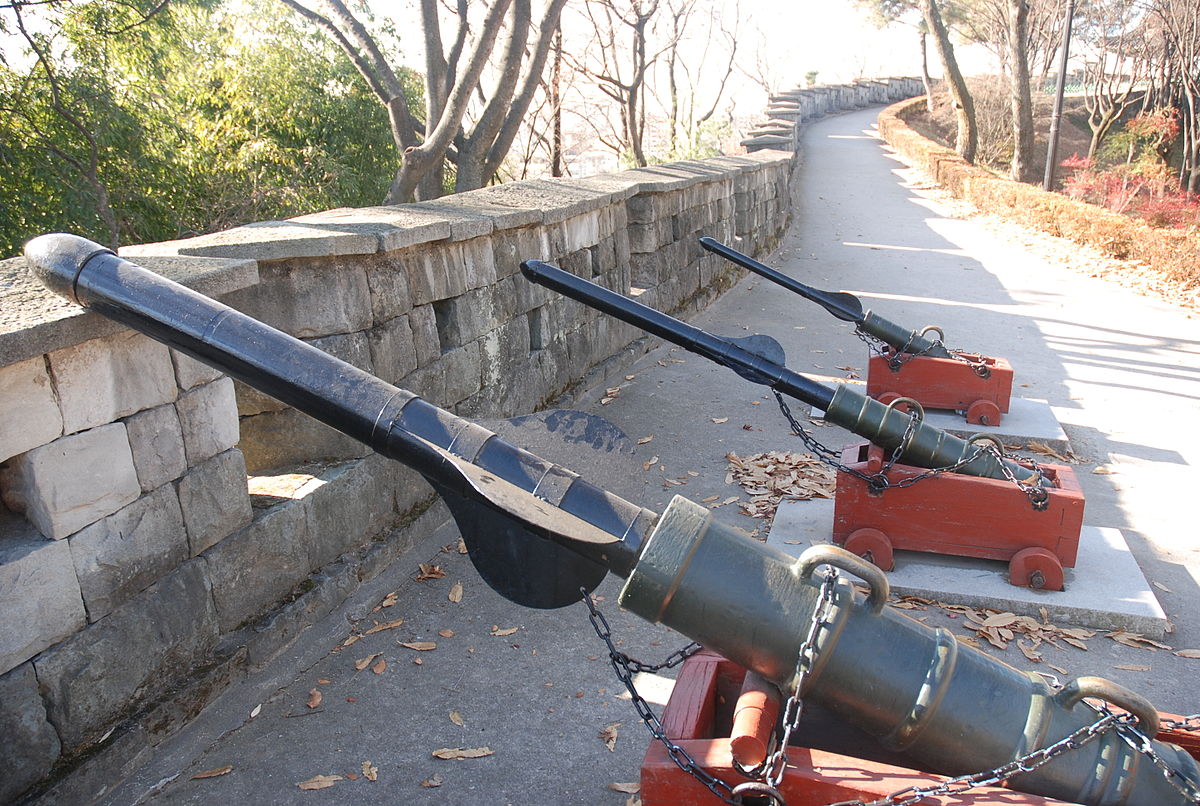The first one is a chija-ch’ongt’ong which was the second largest of the cannons that appeared in the mid-1500s. The second was a pyorhwangja which was a swivel gun variant of the smallest cannon, the hwangja, which appeared during the Imjin War or shortly after. The third was a hyonja which was the second smallest.

The first one is a chija-ch’ongt’ong which was the second largest of the cannons that appeared in the mid-1500s. The second was a pyorhwangja which was a swivel gun variant of the smallest cannon, the hwangja, which appeared during the Imjin War or shortly after. The third was a hyonja which was the second smallest.
The turtle ship was equipped with Cheonja “Heaven”, Jija “Earth”, Hyeonja “Black”, and Hwangja “Yellow” type chongtong (Joseon cannons). There was also an arquebus known as Seungja (Victory). The Seungja ranged 200 metres (660 ft) while the Hwangja was the lightest but with a range of 1,200 metres (3,900 ft). According to Hae-Ill Bak, one Japanese record of the Battle of Angolpo records the experience of two Japanese commanders on July 9, 1592 in their battle against turtle ships: “their (turtle ships’) attack continued until about 6 o’clock in the afternoon by firing large fire-arrows through repeated alternate approaches, even as close as 18-30 feet. As a result, almost every part of our ships – the turret, the passages and the side shielding – were totally destroyed…”
The bolts from the Korean guns look very heavy and large. That means, with the same powder charge and quality, the range would be very limited compared to a gun firing plain metal ball, and effective range even more so with the low muzzle velocity. At this effective range the impact would be devastating though.
I can see them working as a kind of counterpart to carronades – very short range, very big punch, but… They will miss out on the bonus of carronade, which was relatively small weight for the projectile weight. Still, since the concept is already there, they may be available earlier, especially for ship armament and perhaps for sieges (though getting close enough would be a challenge). But the ship then either should have a mixed battery… Or the gun needs to be “universal” – at longer ranges firing shot, at short ranges the bolt (and extra arrangements for reloading).
But overall this style of bolts would be always tied by the need to have them sticking out. I do not really see any option to make a discarding sabot arrangement reliable enough and giving enough benefit to make such thing work in given time period. Maybe by the late 19th century you can have shells with spring-loaded fins (kinda like RPG-7) but that would be solution looking for problem at that time.
According to partially confirmed information, largest of such cannons “cheonja-chongtong” which fired 30 kg (66 pounds) heavy bolt had a maximum range of ~ 1600 m. With help of some math, I eventually ended up estimating its muzzle velocity to be around 140-170 m/s. These cannons were being improved from 15th to 18th century but except for minor improvement, there was no major overhaul.
In fact, the bolt fining cannons were gradually pushed out by Chinese take on European Culverins named Hongyipao.
Muzzle velocity of 140-170 m/s that I calculated is greatly below what the potential of black powder cannon can do, so it appears there is lot of space to improve that. However, that would require a thicker cannon, that can withstand a larger charge (Cheonja Chongtong apparently used only a bit over 1kg charge to fire the 30 kg bolt) and also making the cannon longer would improve its efficiency. Actually without making the cannon longer, the improvement we can achieve is limited.
Which is where the problem is. These bolts have to have fins to have stable flight and accuracy. And so, making the cannon longer without making the bolt longer poses a problem, as in the historical version, bolt was put into cannon in a way that fins were in front of the muzzle.